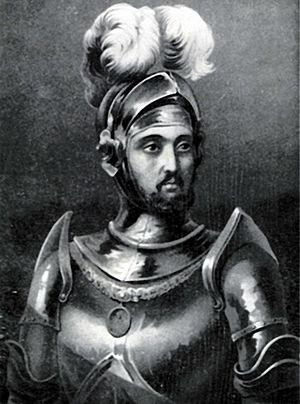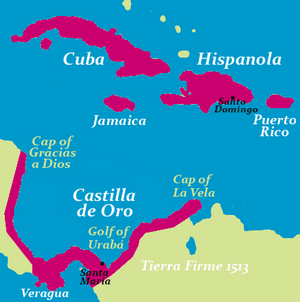Diego Columbus facts for kids
Quick facts for kids
Diego Columbus
|
|
|---|---|

Portrait of Diego Columbus
|
|
| 2nd Viceroy of the Indies | |
| In office 1511–1526 |
|
| Monarch | Joanna of Castile (1511–1526), Charles I of Spain (1516–1526) |
| Preceded by | Christopher Columbus |
| Succeeded by | Antonio de Mendoza (as Viceroy of New Spain) |
| 2nd Admiral of the Indies | |
| In office 1506–1526 |
|
| Monarch | Joanna of Castile (1506–1526), Philip I of Castile (1506), Charles I of Spain (1516–1526) |
| Preceded by | Christopher Columbus |
| Succeeded by | Luis Colón de Toledo |
| 4th Governor of the Indies | |
| In office 1509–1518 |
|
| Appointed by | Ferdinand II of Aragon, as regent to Joanna of Castile (1508) |
| Preceded by | Nicolás de Ovando y Cáceres |
| 1st Duke of Veragua, 1st Marquess of Jamaica | |
| In office 1509–1526 |
|
| Appointed by | Ferdinand II of Aragon, as regent to Joanna of Castile (1508) |
| Succeeded by | Luis Colón de Toledo |
| Personal details | |
| Born | April 1, 1479 Kingdom of Portugal |
| Died | February 23, 1526 (aged 45) La Puebla de Montalbán, Spain |
| Spouse | María de Toledo y Rojas |
| Children | 5, including Luis |
| Parents | Christopher Columbus Filipa Moniz Perestrelo |
| Residence | Viceregal Palace of Columbus |
| Occupation | Navigator Explorer |
Diego Columbus (Portuguese: Diogo Colombo; Spanish: Diego Colón; Italian: Diego Colombo; 1479/1480 – February 23, 1526) was an important navigator and explorer. He worked for the Kings of Castile and Aragón. He was the eldest son of the famous explorer Christopher Columbus.
Diego held several important titles in the New World. He was the 2nd Admiral of the Indies, the 2nd Viceroy of the Indies, and the 4th Governor of the Indies. He was born in Portugal, either in Porto Santo or Lisbon. Much of his life was spent trying to get back the special titles and rights that his father, Christopher Columbus, had been given but then lost. His marriage to María de Toledo y Rojas, who was related to King Ferdinand, helped him a lot in this goal.
Contents
Early Life of Diego Columbus
Diego Columbus became a page at the Spanish royal court in 1492. This was the same year his father, Christopher Columbus, began his first voyage across the Atlantic Ocean. Diego also had a younger half-brother named Fernando.
Both Diego and Fernando served as pages for important royal figures. First, they were pages for Prince Don Juan, and later they became pages for Queen Isabella in 1497.
Diego Columbus as Viceroy
In August 1508, Diego Columbus was named Governor of the Indies. This was the same important job his father had once held. Diego arrived in Santo Domingo in July 1509. He built his home there, called the Alcázar de Colón, which you can still see today in what is now the Dominican Republic.
In 1511, as Viceroy of the Indies, Diego Columbus sent Diego Velázquez de Cuéllar on an expedition. This trip went from Santo Domingo to the island of Cuba, which Spain had recently claimed.
Diego arrived with many important people, including his wife, Doña Maria. She was the first "gran dama" (important lady) of the New World. His half-brother, uncles, and other relatives also came with him. This arrival showed that the Columbus family was now a very important and powerful family in the islands.
In 1511, a royal council decided that Hispaniola, Puerto Rico, Jamaica, and Cuba were under Diego's control. They said this was his right because of his father's discoveries. The council also confirmed that Diego's titles of Viceroy and Admiral could be passed down in his family. He was also allowed to receive a part of the royal income.
However, problems soon started between those who supported Diego and the king's own officials. Things got so bad that King Ferdinand called Diego back to Spain in 1514. Diego spent the next five years in Spain trying to get his claims and titles back. Finally, in 1520, King Charles gave Diego his powers back.
Diego returned to Santo Domingo in November 1520. At this time, there was a rebellion by native people against Spanish rule in the area of the Cumana River. This area was known for Spanish activities like getting salt and pearls. Diego sent an expedition to deal with the rebellion. Later, in 1521, Diego supported a plan by Bartolomé de las Casas to settle the Cumana area. This plan failed, and Diego was blamed, causing him to lose the king's trust. Because of this, and Diego's actions in Cuba, King Charles called him back to Spain again in 1523.
A significant event happened in Santo Domingo on December 26, 1522. Workers on Diego's sugar plantation started a rebellion. Many of these workers managed to escape into the mountains. There, they formed independent communities among the surviving native people. However, many rebels were captured, and Diego had them punished.
Death and Legacy
Diego Columbus passed away on February 23, 1526, in Spain. After his death, there was a disagreement among his family about who should inherit his titles and rights in the New World.
In 1536, a solution was reached. His son, Luis Colón de Toledo, was named Admiral of the Indies. In return, Luis gave up all other claims for a yearly payment. He also received the island of Jamaica as a special land grant and a large estate in what is now Panama. He was also given the titles of Duke of Veragua and Marquess of Jamaica.
Family Life
Diego Columbus married María de Toledo y Rojas (around 1490 – May 11, 1549). She was a cousin of the king. María played an important role in arranging for her father-in-law, Christopher Columbus, to be buried in Santo Domingo.
Diego and María had several children, including:
- María Colón de Toledo
- Luis Colón, 1st Duke of Veragua
- Cristóbal Colón de Toledo
- Juana Colón de Toledo
- Isabel Colón de Toledo
See also
 In Spanish: Diego Colón para niños
In Spanish: Diego Colón para niños



